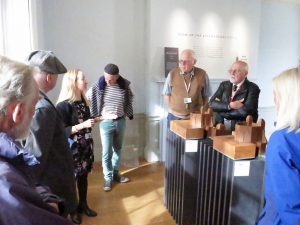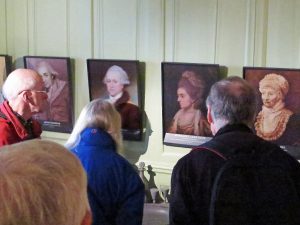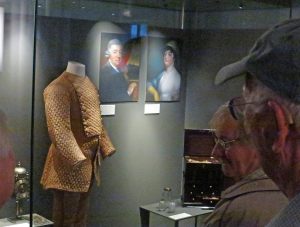September 23, 2017
FAS Curator Tour of Observatory Life at the ROG, September 23, 2017
Report by: Mike Dryland
The exhibition called Observatory Life in the ‘astronomer’s apartments’ at the ROG has been under development for some time. It tells the stories of two of the Astronomers Royal and their families who lived and worked at the Observatory. The curator of the Royal Observatory, Dr Louise Devoy, generously agreed to show us round the exhibits on a Saturday.
Louise explained the background to the exhibition – it addresses one of the Observatory stories not previously told in the ROG galleries: about the families and lives of the Astronomers Royal. The building now called Flamsteed House was home to ten ARs and their families, from John Flamsteed to Sir Harold Spencer Jones, after which the work moved to Herstmonceux on the south coast. It was not possible to tell the stories of all ten families. The choice of the Maskelynes (AR 1765-1811) and the Airys (AR 1835-1881) was helped in large part by the families of their descendants who loaned a number of spectacular items not previously exhibited. As we toured the galleries Louise talked about the items on display.
The entrance gallery contains three models of Flamsteed House showing how it developed from the original Wren building with extensions by Bradley, Maskelyne, and Airy. It was something of a challenge to depict the development in a way easily and quickly grasped, and there still remains some thinking to be done about possible future alterations to make the models clearer.
The first two apartment rooms are devoted to the Maskelynes who were well-connected to leading members of the scientific establishment. The first room represents a dining room and features portraits of prominent friends who came to visit. Inscribed on the ‘dining table’ are some of the notes from Nevil Maskelyne’s diaries and notebooks recording recipes and remedies. The display case features several interesting items associated with the family including a spectacular globe, one of a pair. Hanging on the wall is a portrait of Nevil and Sophia Maskelyne’s daughter, Margaret, their only child.
The star of the second room is Maskelyne’s observing suit – a striking one-piece padded silk suit with integral feet, to keep him warm when working at night. This has been loaned by the family and was used in the past for children’s dressing up! Also in this room is a ‘smells experience’ – three fragrances have been created based on Maskelyne’s notes so visitors can follow their noses around the household.
Rooms three and four contain exhibits about the Airy family. Sir George and Richarda Airy had nine children of whom six survived to adulthood and were raised in Flamsteed House. The third room contains a family portrait, items used by the children, and extracts of notes about family life. The fourth room is dominated by an imposing portrait of Sir George himself – a rather reluctant knight who at first refused the honour on the grounds of expense. The display case contains several of Sir George’s awards and gifts from the British and other governments which Sir George helped on all manner of scientific and engineering projects. The room features a soundscape playing recordings taken from Richarda Airy’s diary.
Louise added many interesting background comments about the families and exhibits. She described some of the difficulties which needed to be overcome to mount the exhibition.
Many thanks to Louise for a fascinating tour and introduction to a most interesting exhibition which is well worth another visit to study.
Pictures from the Tour (by Mike Dryland):
Posted under: Flamsteed, History of Astronomy, Meeting Report, Society Trip






























You must be logged in to post a comment.